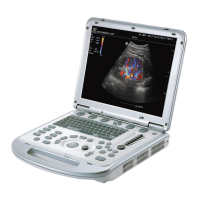5-42 Image Optimization
a
b c
Amniotic fluid(AF) isolation
The region desired is isolated by amniotic fluid adequately.
The region to imaging is not covered by limbs or umbilical cord.
The best condition is that the fetus keeps still. If there is a fetal movement in
Smart 3D or Static 3D imaging, you need a rescanning when the fetus is still.
Angle of a B tangent plane
The optimum tangent plane to the fetal face 3D/4D imaging is the sagittal section of
the face, or the coronal section. To ensure high image quality, you’d better scan
maximum face area and keep edge continuity.
Image quality in B mode (2D image quality)
Before entering 3D/4D capture, optimize the B mode image to assure:
High contrast between the desired region and the AF surrounded.
Clear boundary of the desired region.
Low noise of the AF area.
Scanning technique (only for Smart3D)
Stability: body, arm and wrist must move smoothly, otherwise the restructured 3D
image distorts.
Slowness: move or rotate the probe slowly. The speed of linear scan is about 2
cm/s and the rotation rate of the fan scan is about 10°/s ~15°/s.
Evenness: move or rotate the probe at a steady speed or rate.
NOTE:
1.
A region with qualified image in B mode may not be optimal for 3D/4D
imaging.
E.g. adequate AF isolation for one sectional plane doesn’t mean the whole
desired region is isolated by AF.
2.
More practices are needed for a high success rate of qualified 3D/4D
imaging.
3.
Even with good fetal condition, to acquire an approving 3D/4D image may
need more than one scanning.
5.11.2 Overview
Ultrasound data based on three-dimensional imaging methods can be used to image any
structure where a view can’t be achieved by standard 2D-mode to improve understanding
of complex structures.
4D provides continuous, high volume acquisition of 3D images. 4D adds the dimension of
“movement” to a 3D image by providing continuous, real-time displays.

